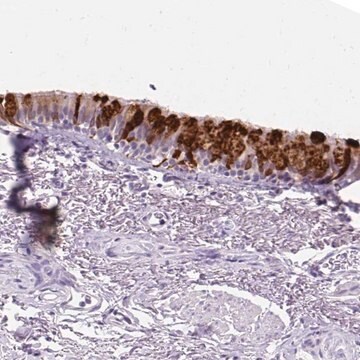ABS1673
Anti-Uteroglobin
serum, from goat
Synonyme(s) :
Clara cell phospholipid-binding protein, CCPBP, Clara cells 10 kDa secretory protein, CC10, PCB-binding protein, Secretoglobin family 1A member 1, Blastokinin
About This Item
Produits recommandés
Source biologique
goat
Niveau de qualité
Forme d'anticorps
serum
Type de produit anticorps
primary antibodies
Clone
polyclonal
Espèces réactives
mouse
Réactivité de l'espèce (prédite par homologie)
rat (based on 100% sequence homology)
Technique(s)
immunofluorescence: suitable
immunohistochemistry: suitable
western blot: suitable
Numéro d'accès NCBI
Numéro d'accès UniProt
Conditions d'expédition
ambient
Modification post-traductionnelle de la cible
unmodified
Informations sur le gène
mouse ... Scgb1A1(22287)
rat ... Scgb1A1(25575)
Description générale
Spécificité
Immunogène
Application
Immunofluorescence Analysis: A 1:1,000 dilution from a representative lot detected Uteroglobin in mouse lung tissue. (Courtesy of Dr.Barry Stripp at Cedars-Sinai Medical Center, Los Angeles, CA).
Immunohistochemistry Analysis: A representative lot detected Uteroglobin in adult mice alveoli (Rawlins, E.L., et. al. (2009). Cell Stem Cell. 4(6):525-34).
Signaling
Qualité
Western Blotting Analysis: A 1:500 dilution of this antibody detected Uteroglobin in 10 µg of mouse lung tissue lysate.
Description de la cible
Forme physique
Stockage et stabilité
Autres remarques
Clause de non-responsabilité
Vous ne trouvez pas le bon produit ?
Essayez notre Outil de sélection de produits.
Code de la classe de stockage
12 - Non Combustible Liquids
Classe de danger pour l'eau (WGK)
WGK 1
Certificats d'analyse (COA)
Recherchez un Certificats d'analyse (COA) en saisissant le numéro de lot du produit. Les numéros de lot figurent sur l'étiquette du produit après les mots "Lot" ou "Batch".
Déjà en possession de ce produit ?
Retrouvez la documentation relative aux produits que vous avez récemment achetés dans la Bibliothèque de documents.
Notre équipe de scientifiques dispose d'une expérience dans tous les secteurs de la recherche, notamment en sciences de la vie, science des matériaux, synthèse chimique, chromatographie, analyse et dans de nombreux autres domaines..
Contacter notre Service technique




